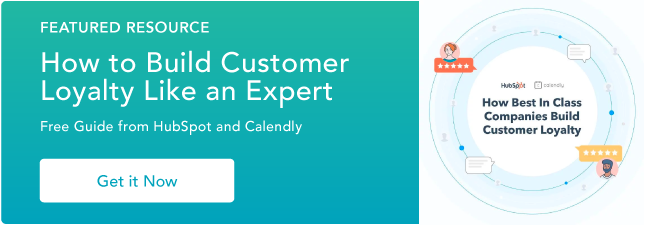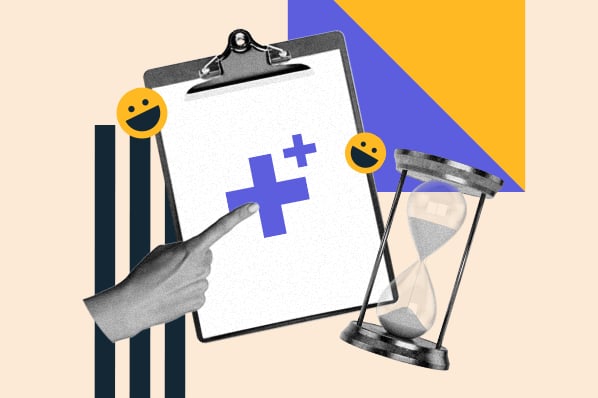What is a customer loyalty survey?
A customer loyalty survey is a questionnaire that’s sent to customers to measure their commitment to your brand. It measures their trust levels, the likelihood of recommending your brand to others, and whether they’d make repeat purchases.
Although they’re similar, loyalty surveys shouldn’t be confused with customer satisfaction surveys. Satisfaction surveys focus on the past (experiences with products or customer support), and loyalty surveys focus on the future (if they’ll ever do business with you again).
For example, a business would send out a satisfaction survey after a support call. It would contain questions about how well a representative solved their issue or if they still need help. The same business could send out a loyalty survey after a product is purchased and ask if they would recommend it to a friend.
Next, we’ll go over key considerations for creating a customer loyalty survey for your business.
How To Make a Customer Loyalty Survey
A critical step in creating your survey is understanding the information you’re hoping to collect. There are three areas that customer loyalty questions can address:
- Customer Retention: retention questions tell you whether a customer would ever consider a competitor or if they’re completely loyal to your business. Retention can also be called lifetime value.
- Advocacy: these questions let you know how likely a customer is to recommend you to friends, family, or other consumers. Advocacy is also referred to as Net Promoter Score®.
- Purchasing power: sometimes called repeat purchase ratio, answers to these questions explain the extent to which a customer will make repeat purchases or increase their purchasing behavior.
Your survey questions can address a single aspect of customer loyalty or a combination of the three. It’s also essential to decide on a measurement scale. There are a variety of options available, and here are some examples:
- Likert scale: this unit of measurement is a five to seven-point scale of numbers that align with phrases like “not at all likely,” or “highly likely.” The image below is an example of a Likert scale.

- Dichotomous scale: this scale typically offers two straightforward responses, like “yes,” or “no.” They’re quick and easy to answer and don’t leave much room for interpretation. The image below is an example of a dichotomous scale.

- Open-ended: these questions require customers to input responses in an empty text field. It produces qualitative feedback from customers that’s more in-depth and personalized than the other scale items. The image below is an example of an open-ended question.

Lastly, the survey should require minimal customer effort. Asking questions that require a significant amount of thought or asking for too much information at once may cause incomplete responses.
Given these factors, let’s go over some sample questions you can include in your loyalty survey.
Customer Loyalty Survey Questions
You can include all of the questions below in a customer loyalty survey. Many of them address various aspects of loyalty and can be used interchangeably.
1. How likely are you to recommend [product, service, business name, brand] to others?
This question addresses advocacy, and responses will give you a sense of your customers’ promotional value. There can be different iterations of this question depending on the scale you use. For example, a dichotomous scale question could be “Would you recommend [product, service, business name, brand] to others?”
2. How long have you been involved with our business?
This question explains retention and lifetime value. You can use a Likert scale for this question or accept open-ended responses.
3. How likely are you to switch to a competitor?
Responses to this question will address customer retention as well as loyalty. With a Likert scale, lower numbers will indicate loyal customers while higher numbers will indicate that customers are lower on the customer loyalty ladder and may still be considering competitors.
If you’re using a dichotomous scale, you could write this question as “Would you ever buy [product name, service name, etc.] from another company?”
4. Would you be willing to try our other [products, services, etc.]?
This question addresses purchasing power, and a dichotomous scale would provide you with straightforward answers. But, if you’d like to use a Likert scale instead, you can word this question as, “How likely are you to try our [product name, service name]?”
5. Would you purchase [product name, service name, etc.] again?
Like question four, responses to this question explain both purchasing power and lifetime value. You’ll understand if customers would repurchase a product or move on to a competitor. If you’re using a Likert scale, the question could be “How likely are you to purchase [product name, service name, etc.] again?”
6. Would you be interested in a loyalty program?
This question also addresses retention and purchasing power, as loyalty programs typically offer rewards after a certain number of purchases. A customer would need to continue making purchases to receive rewards, inspiring both loyalty and driving revenue.
If you’re using a Likert scale, the question could be, “How likely are you to enroll in our loyalty program?”
7. How satisfied are you with our business?
Although this question mentions satisfaction, it can also explain advocacy and retention. Customers reporting higher satisfaction levels are probably more loyal, more likely to make repeat purchases, and more likely to recommend you to others.
8. Would you continue to do business with [company name] if prices increased?
This question addresses retention because responses let you know that your customers are loyal to your products not because of the cost but because they’re valuable. Essentially, they would make repeat purchases despite higher costs. The question can be reworded to “How likely are you to purchase [product or service name] again if the price increased?” for a Likert scale.
9. Would you consider yourself a loyal customer of [business name]?
A straightforward question for a straightforward answer; it’s a different way of asking questions one and three. You can write this question as “On a scale of [metric numbers] how loyal do you consider yourself to be to [business name]?” for a Likert scale.
10. I purchase products from [business name] because I want to, not because there isn’t an alternative.
You can pose this question on a Likert scale, and responses will provide insight into customer retention.
Don't Assume Loyalty, Ask About It
Although it would be nice, you can’t assume that customers are loyal just because they seem loyal.
A customer may like your product because it’s affordable, but a price increase would prompt them to switch to a competitor. Also, since brand commitment to social issues is increasingly important, a long-time customer may drop your company and never look back after your business makes a PR mistake — like making an inappropriate comment online.
In sum, directly asking your customers how they feel is the best way to understand their commitment to your company, and a customer loyalty survey will give you the information you need to retain their business.
Once you’ve created your survey and collected data, learn how to analyze the results.
Net Promoter, Net Promoter System, Net Promoter Score®, NPS®, and the NPS-related emoticons are registered trademarks of Bain & Company, Inc., Fred Reichheld, and Satmetrix Systems, Inc.
Customer Loyalty
.png?width=112&height=112&name=Image%20Hackathon%20%E2%80%93%20Square%20(30).png)


-4.png)



-1.webp)


![How & Why Loyalty Punch Cards Attract Customers to Your Brand [+ Examples]](https://53.fs1.hubspotusercontent-na1.net/hubfs/53/customer-loyalty-punch-card_6.webp)

